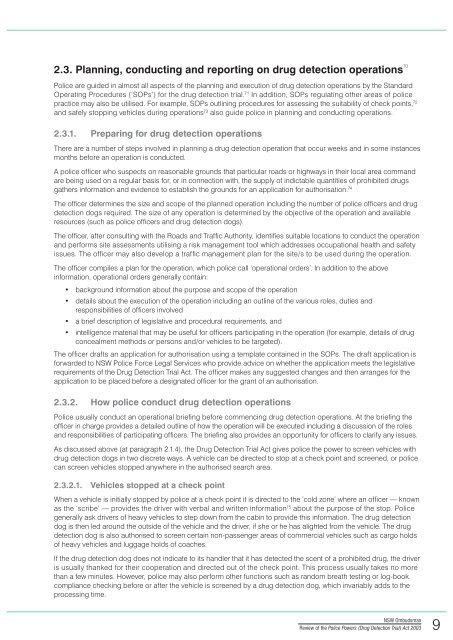Review of the Police Powers (Drug Detection Trial) Act 2003 - NSW ...
Review of the Police Powers (Drug Detection Trial) Act 2003 - NSW ...
Review of the Police Powers (Drug Detection Trial) Act 2003 - NSW ...
You also want an ePaper? Increase the reach of your titles
YUMPU automatically turns print PDFs into web optimized ePapers that Google loves.
2.3. Planning, conducting and reporting on drug detection operations 70<br />
<strong>Police</strong> are guided in almost all aspects <strong>of</strong> <strong>the</strong> planning and execution <strong>of</strong> drug detection operations by <strong>the</strong> Standard<br />
Operating Procedures (‘SOPs’) for <strong>the</strong> drug detection trial. 71 In addition, SOPs regulating o<strong>the</strong>r areas <strong>of</strong> police<br />
practice may also be utilised. For example, SOPs outlining procedures for assessing <strong>the</strong> suitability <strong>of</strong> check points, 72<br />
and safely stopping vehicles during operations 73 also guide police in planning and conducting operations.<br />
2.3.1. Preparing for drug detection operations<br />
There are a number <strong>of</strong> steps involved in planning a drug detection operation that occur weeks and in some instances<br />
months before an operation is conducted.<br />
A police <strong>of</strong>ficer who suspects on reasonable grounds that particular roads or highways in <strong>the</strong>ir local area command<br />
are being used on a regular basis for, or in connection with, <strong>the</strong> supply <strong>of</strong> indictable quantities <strong>of</strong> prohibited drugs<br />
ga<strong>the</strong>rs information and evidence to establish <strong>the</strong> grounds for an application for authorisation. 74<br />
The <strong>of</strong>ficer determines <strong>the</strong> size and scope <strong>of</strong> <strong>the</strong> planned operation including <strong>the</strong> number <strong>of</strong> police <strong>of</strong>ficers and drug<br />
detection dogs required. The size <strong>of</strong> any operation is determined by <strong>the</strong> objective <strong>of</strong> <strong>the</strong> operation and available<br />
resources (such as police <strong>of</strong>ficers and drug detection dogs).<br />
The <strong>of</strong>ficer, after consulting with <strong>the</strong> Roads and Traffic Authority, identifies suitable locations to conduct <strong>the</strong> operation<br />
and performs site assessments utilising a risk management tool which addresses occupational health and safety<br />
issues. The <strong>of</strong>ficer may also develop a traffic management plan for <strong>the</strong> site/s to be used during <strong>the</strong> operation.<br />
The <strong>of</strong>ficer compiles a plan for <strong>the</strong> operation, which police call ‘operational orders’. In addition to <strong>the</strong> above<br />
information, operational orders generally contain:<br />
• background information about <strong>the</strong> purpose and scope <strong>of</strong> <strong>the</strong> operation<br />
• details about <strong>the</strong> execution <strong>of</strong> <strong>the</strong> operation including an outline <strong>of</strong> <strong>the</strong> various roles, duties and<br />
responsibilities <strong>of</strong> <strong>of</strong>ficers involved<br />
• a brief description <strong>of</strong> legislative and procedural requirements, and<br />
• intelligence material that may be useful for <strong>of</strong>ficers participating in <strong>the</strong> operation (for example, details <strong>of</strong> drug<br />
concealment methods or persons and/or vehicles to be targeted).<br />
The <strong>of</strong>ficer drafts an application for authorisation using a template contained in <strong>the</strong> SOPs. The draft application is<br />
forwarded to <strong>NSW</strong> <strong>Police</strong> Force Legal Services who provide advice on whe<strong>the</strong>r <strong>the</strong> application meets <strong>the</strong> legislative<br />
requirements <strong>of</strong> <strong>the</strong> <strong>Drug</strong> <strong>Detection</strong> <strong>Trial</strong> <strong>Act</strong>. The <strong>of</strong>ficer makes any suggested changes and <strong>the</strong>n arranges for <strong>the</strong><br />
application to be placed before a designated <strong>of</strong>ficer for <strong>the</strong> grant <strong>of</strong> an authorisation.<br />
2.3.2. How police conduct drug detection operations<br />
<strong>Police</strong> usually conduct an operational briefing before commencing drug detection operations. At <strong>the</strong> briefing <strong>the</strong><br />
<strong>of</strong>ficer in charge provides a detailed outline <strong>of</strong> how <strong>the</strong> operation will be executed including a discussion <strong>of</strong> <strong>the</strong> roles<br />
and responsibilities <strong>of</strong> participating <strong>of</strong>ficers. The briefing also provides an opportunity for <strong>of</strong>ficers to clarify any issues.<br />
As discussed above (at paragraph 2.1.4), <strong>the</strong> <strong>Drug</strong> <strong>Detection</strong> <strong>Trial</strong> <strong>Act</strong> gives police <strong>the</strong> power to screen vehicles with<br />
drug detection dogs in two discrete ways. A vehicle can be directed to stop at a check point and screened, or police<br />
can screen vehicles stopped anywhere in <strong>the</strong> authorised search area.<br />
2.3.2.1. Vehicles stopped at a check point<br />
When a vehicle is initially stopped by police at a check point it is directed to <strong>the</strong> ‘cold zone’ where an <strong>of</strong>ficer — known<br />
as <strong>the</strong> ‘scribe’ — provides <strong>the</strong> driver with verbal and written information 75 about <strong>the</strong> purpose <strong>of</strong> <strong>the</strong> stop. <strong>Police</strong><br />
generally ask drivers <strong>of</strong> heavy vehicles to step down from <strong>the</strong> cabin to provide this information. The drug detection<br />
dog is <strong>the</strong>n led around <strong>the</strong> outside <strong>of</strong> <strong>the</strong> vehicle and <strong>the</strong> driver, if she or he has alighted from <strong>the</strong> vehicle. The drug<br />
detection dog is also authorised to screen certain non-passenger areas <strong>of</strong> commercial vehicles such as cargo holds<br />
<strong>of</strong> heavy vehicles and luggage holds <strong>of</strong> coaches.<br />
If <strong>the</strong> drug detection dog does not indicate to its handler that it has detected <strong>the</strong> scent <strong>of</strong> a prohibited drug, <strong>the</strong> driver<br />
is usually thanked for <strong>the</strong>ir cooperation and directed out <strong>of</strong> <strong>the</strong> check point. This process usually takes no more<br />
than a few minutes. However, police may also perform o<strong>the</strong>r functions such as random breath testing or log-book<br />
compliance checking before or after <strong>the</strong> vehicle is screened by a drug detection dog, which invariably adds to <strong>the</strong><br />
processing time.<br />
<strong>NSW</strong> Ombudsman<br />
<strong>Review</strong> <strong>of</strong> <strong>the</strong> <strong>Police</strong> <strong>Powers</strong> (<strong>Drug</strong> <strong>Detection</strong> <strong>Trial</strong>) <strong>Act</strong> <strong>2003</strong><br />
9

















